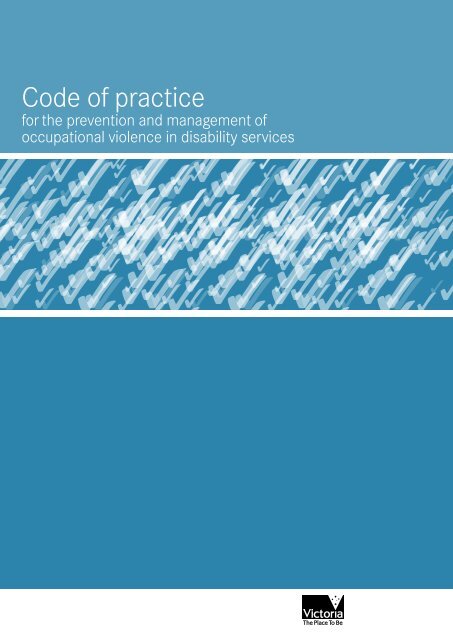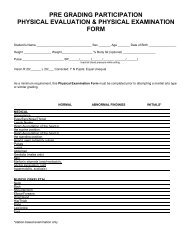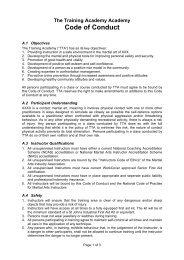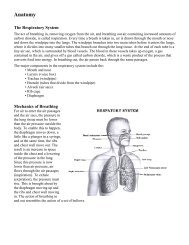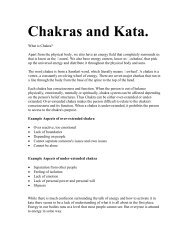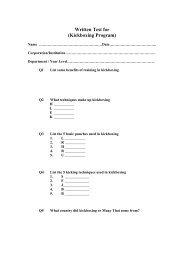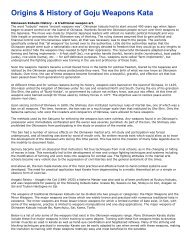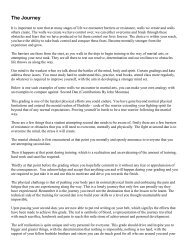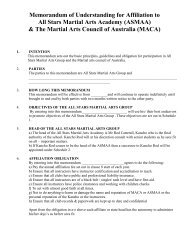Occupational violence in Disability Services code of practice (PDF
Occupational violence in Disability Services code of practice (PDF
Occupational violence in Disability Services code of practice (PDF
You also want an ePaper? Increase the reach of your titles
YUMPU automatically turns print PDFs into web optimized ePapers that Google loves.
Code <strong>of</strong> <strong>practice</strong><br />
for the prevention and management <strong>of</strong><br />
occupational <strong>violence</strong> <strong>in</strong> disability services<br />
✓ ✓ ✓ ✓ ✓ ✓ ✓ ✓<br />
✓ ✓ ✓ ✓ ✓ ✓ ✓ ✓ ✓ ✓ ✓<br />
✓ ✓ ✓ ✓ ✓ ✓ ✓ ✓ ✓ ✓ ✓ ✓ ✓ ✓ ✓ ✓ ✓ ✓ ✓<br />
✓ ✓ ✓ ✓ ✓<br />
✓ ✓ ✓ ✓ ✓ ✓<br />
✓ ✓ ✓ ✓ ✓ ✓ ✓<br />
✓ ✓ ✓ ✓ ✓ ✓<br />
✓ ✓ ✓ ✓ ✓ ✓<br />
✓ ✓ ✓ ✓
Code <strong>of</strong> <strong>practice</strong> for the prevention and<br />
management <strong>of</strong> occupational <strong>violence</strong> <strong>in</strong><br />
disability services
ii Code <strong>of</strong> <strong>practice</strong> for the prevention and management <strong>of</strong> occupational <strong>violence</strong> <strong>in</strong> disability services<br />
Disclaimer<br />
Published by <strong>Disability</strong> <strong>Services</strong> Division<br />
Victorian Government Department <strong>of</strong><br />
Human <strong>Services</strong><br />
Melbourne Victoria Australia<br />
August 2007<br />
© Copyright State <strong>of</strong> Victoria, Department<br />
<strong>of</strong> Human <strong>Services</strong>, 2007.<br />
This publication is copyright. No part may<br />
be reproduced by any process except <strong>in</strong><br />
accordance with the provisions <strong>of</strong> the<br />
Copyright Act 1968.<br />
Authorised by the Victorian Government,<br />
50 Lonsdale Street, Melbourne.
Code <strong>of</strong> <strong>practice</strong> for the prevention and management <strong>of</strong> occupational <strong>violence</strong> <strong>in</strong> disability services iii<br />
Contents<br />
1. Introduction 1<br />
1.1 What is the purpose <strong>of</strong> the <strong>code</strong> 1<br />
1.2 What is occupational <strong>violence</strong> 1<br />
1.3 What is the <strong>code</strong> based on 1<br />
1.4 How has the <strong>code</strong> been developed 1<br />
1.5 How can the <strong>code</strong> be used 1<br />
2. OHS legal requirements and occupational <strong>violence</strong> 3<br />
2.1 Understand<strong>in</strong>g the OHS law 3<br />
2.2 Employer duties 3<br />
2.3 Employee duties 3<br />
2.4 Contractors 4<br />
2.5 Temp agencies 4<br />
2.6 Designers <strong>of</strong> disability services facilities 4<br />
2.7 Family and visitors 4<br />
2.8 Balanc<strong>in</strong>g OHS with other legal duties 5<br />
3. Plann<strong>in</strong>g to prevent occupational <strong>violence</strong> 6<br />
3.1 General 6<br />
3.2 Assign OHS responsibilities 6<br />
3.3 Consultation 9<br />
3.4 Assessment and placement 10<br />
3.5 Communication and <strong>in</strong>formation shar<strong>in</strong>g 10<br />
3.6 Tra<strong>in</strong><strong>in</strong>g 11<br />
3.7 Recruitment 13<br />
3.8 Staff<strong>in</strong>g and roster<strong>in</strong>g 14<br />
4. Risk management for occupational <strong>violence</strong> <strong>in</strong><br />
accommodation services 15<br />
4.1 Risk management approach 15<br />
4.2 Understand<strong>in</strong>g occupational <strong>violence</strong> hazards 16<br />
4.3 Risk Assessment 16<br />
4.4 Risk Control 18<br />
4.5 How to evaluate risk controls 18<br />
4.6 What are reasonably practicable risk controls 19<br />
4.7 Case studies <strong>in</strong> manag<strong>in</strong>g occupational <strong>violence</strong> 21<br />
4.8 Risk control: Restrictive Interventions 24<br />
5. Risk Management <strong>in</strong> other <strong>Disability</strong> <strong>Services</strong> sett<strong>in</strong>gs 25<br />
5.1 Client services and outreach 25<br />
5.2 Forensic mental health 25
iv Code <strong>of</strong> <strong>practice</strong> for the prevention and management <strong>of</strong> occupational <strong>violence</strong> <strong>in</strong> disability services<br />
6. Review and response 26<br />
6.1 Manag<strong>in</strong>g change 26<br />
6.2 Emergency Response: 26<br />
6.3 Post <strong>in</strong>cident Response 27<br />
6.4 Incident report<strong>in</strong>g 27<br />
6.5 Investigat<strong>in</strong>g <strong>in</strong>cidents 28<br />
6.6 Review 29<br />
7. Appendix 1: Recent case 30<br />
8. Appendix 2: Case study format 31<br />
9. References 32
Code <strong>of</strong> <strong>practice</strong> for the prevention and management <strong>of</strong> occupational <strong>violence</strong> <strong>in</strong> disability services <br />
1. Introduction<br />
1.1 What is the purpose<br />
<strong>of</strong> the <strong>code</strong><br />
1.2 What is occupational<br />
<strong>violence</strong><br />
1.3 What is the <strong>code</strong><br />
based on<br />
1.4 How has the <strong>code</strong><br />
been developed<br />
1.5 How can the <strong>code</strong><br />
be used<br />
The purpose <strong>of</strong> the <strong>code</strong> is to provide practical guidance on how to prevent and<br />
manage occupational <strong>violence</strong> <strong>in</strong> disability services.<br />
The <strong>code</strong> provides overall guidance on management <strong>of</strong> occupational <strong>violence</strong> but<br />
does not replace specific policies and procedures on occupational <strong>violence</strong>. Where<br />
relevant these are referenced <strong>in</strong> the <strong>code</strong>.<br />
The <strong>code</strong> primarily addresses occupational <strong>violence</strong> issues with<strong>in</strong> disability<br />
accommodation, as this is the highest exposure area (see Part 4). However much <strong>of</strong><br />
the guidance is also relevant to areas such as outreach and client services<br />
(see Part 5).<br />
The <strong>code</strong> covers services managed by the Department <strong>of</strong> Human <strong>Services</strong> us<strong>in</strong>g<br />
directly employed staff <strong>of</strong> the department.<br />
The <strong>code</strong> covers the matters agreed to <strong>in</strong> the Health <strong>Services</strong> Union <strong>of</strong> Australia<br />
(HSUA) Department <strong>of</strong> Human <strong>Services</strong> <strong>Disability</strong> <strong>Services</strong> Certified Agreement 2004,<br />
section 29.9: <strong>Occupational</strong> Assault.<br />
<strong>Occupational</strong> <strong>violence</strong> is def<strong>in</strong>ed, for the purpose <strong>of</strong> this Code, as any event <strong>in</strong>itiated<br />
by a person receiv<strong>in</strong>g services from the department or member <strong>of</strong> the public, <strong>in</strong><br />
which staff are abused, threatened or assaulted <strong>in</strong> circumstances aris<strong>in</strong>g out <strong>of</strong> or <strong>in</strong><br />
the course <strong>of</strong> their employment.<br />
This <strong>code</strong> reflects the underly<strong>in</strong>g <strong>Occupational</strong> Health and Safety (OHS) legislative<br />
duties <strong>of</strong> the respective parties <strong>in</strong> the <strong>in</strong>dustry (for example employers, employees,<br />
contractors) and the ‘state <strong>of</strong> knowledge’ about manag<strong>in</strong>g occupational <strong>violence</strong> <strong>in</strong><br />
disability services.<br />
The <strong>code</strong> has been produced <strong>in</strong> conjunction with the disability services sector and<br />
their representative bodies to provide guidance on the management <strong>of</strong> occupational<br />
<strong>violence</strong> issues <strong>in</strong> the sector.<br />
This guidance material has been prepared us<strong>in</strong>g <strong>in</strong>formation drawn from the current<br />
<strong>practice</strong>s <strong>of</strong> Victorian Department <strong>of</strong> Human <strong>Services</strong> disability service providers,<br />
and there has been extensive consultation and test<strong>in</strong>g <strong>of</strong> the <strong>code</strong> to ensure it meets<br />
the needs <strong>of</strong> the sector.<br />
<strong>Disability</strong> service providers managed by the department can use the guidance<br />
material to check occupational <strong>violence</strong> prevention <strong>practice</strong>s and, if necessary, br<strong>in</strong>g<br />
<strong>practice</strong>s up to standard.<br />
The <strong>code</strong> also provides a basis for consult<strong>in</strong>g with elected Health and Safety<br />
Representatives (HSR) and employees on occupational health and safety issues.<br />
The OHS legislation and modern health and safety <strong>practice</strong> are based on identify<strong>in</strong>g<br />
hazards, assess<strong>in</strong>g risks and then controll<strong>in</strong>g any risks. Figure 1 illustrates the<br />
general approach.
Code <strong>of</strong> <strong>practice</strong> for the prevention and management <strong>of</strong> occupational <strong>violence</strong> <strong>in</strong> disability services<br />
Figure 1: Approach to manag<strong>in</strong>g occupational <strong>violence</strong>
Code <strong>of</strong> <strong>practice</strong> for the prevention and management <strong>of</strong> occupational <strong>violence</strong> <strong>in</strong> disability services <br />
2. OHS legal requirements and<br />
occupational <strong>violence</strong><br />
2.1 Understand<strong>in</strong>g<br />
the OHS law<br />
The <strong>Occupational</strong> Health and Safety Act (2004) sets out a number <strong>of</strong> pr<strong>in</strong>ciples <strong>of</strong><br />
health and safety. These pr<strong>in</strong>ciples can be summarised as follows:<br />
• People at work <strong>in</strong>clud<strong>in</strong>g employees and other persons should be given the<br />
highest level <strong>of</strong> protection aga<strong>in</strong>st risks to their health and safety that is reasonably<br />
practicable <strong>in</strong> the circumstances.<br />
• Those who control or manage matters that create risks are responsible for<br />
elim<strong>in</strong>at<strong>in</strong>g or reduc<strong>in</strong>g them.<br />
• Employers should be proactive <strong>in</strong> manag<strong>in</strong>g OHS.<br />
• There should be an exchange <strong>of</strong> OHS <strong>in</strong>formation and ideas to elim<strong>in</strong>ate or reduce<br />
risks.<br />
• Employee participation <strong>in</strong> OHS should be encouraged.<br />
In this context the Act def<strong>in</strong>es what responsibilities or duties different persons<br />
have. These duties are described below. In Part 3 these duties are discussed <strong>in</strong> the<br />
context <strong>of</strong> the management <strong>of</strong> occupational <strong>violence</strong> <strong>in</strong> disability services.<br />
2.2 Employer duties Under section 21 <strong>of</strong> the Act an employer has a broad duty or responsibility to<br />
provide and ma<strong>in</strong>ta<strong>in</strong>, so far as is reasonably practicable, a safe and healthy work<strong>in</strong>g<br />
environment for its employees.<br />
The employer duty also extends to other persons <strong>in</strong>clud<strong>in</strong>g people receiv<strong>in</strong>g services<br />
from the employer, visitors, members <strong>of</strong> the public and contractors who may be<br />
engaged to undertake ma<strong>in</strong>tenance works <strong>in</strong> houses.<br />
Duties <strong>of</strong> the employer <strong>in</strong> the disability services sett<strong>in</strong>g <strong>in</strong>clude consult<strong>in</strong>g<br />
employees, assess<strong>in</strong>g occupational <strong>violence</strong> risks, <strong>in</strong>troduc<strong>in</strong>g risk reduction<br />
strategies and keep<strong>in</strong>g records <strong>of</strong> <strong>in</strong>cidents and assessments.<br />
2.3 Employee duties Employees have a duty to employers and to others to take reasonable care and not<br />
put themselves or others at risk by their actions or omissions.<br />
Under the Act employees have a duty to cooperate with the measures that an<br />
employer has developed to elim<strong>in</strong>ate or reduce risks. Consequently employees<br />
must be made aware <strong>of</strong> all <strong>of</strong> their employer’s policies and procedures <strong>in</strong> respect <strong>of</strong><br />
occupational <strong>violence</strong>.<br />
Duties <strong>of</strong> employees <strong>in</strong> the disability services sett<strong>in</strong>g <strong>in</strong>clude follow<strong>in</strong>g behaviour<br />
management strategies, report<strong>in</strong>g <strong>in</strong>cidents and apply<strong>in</strong>g methods for defus<strong>in</strong>g<br />
hazardous situations. Employees are expected to use the tra<strong>in</strong><strong>in</strong>g and <strong>in</strong>formation<br />
provided to work with people receiv<strong>in</strong>g services <strong>in</strong> a way that reduces risks.<br />
It is critical that support staff are aware <strong>of</strong> the impact <strong>of</strong> their actions when work<strong>in</strong>g<br />
with people receiv<strong>in</strong>g services where there is potential for occupational <strong>violence</strong>.
Code <strong>of</strong> <strong>practice</strong> for the prevention and management <strong>of</strong> occupational <strong>violence</strong> <strong>in</strong> disability services<br />
2.4 Contractors Contractors may be required to undertake ma<strong>in</strong>tenance work at disability<br />
accommodation facilities. To meet their duties contractors should meet<br />
requirements <strong>of</strong> Contractors Checklists, follow the directions <strong>of</strong> a house supervisor<br />
or unit manager (or other senior person) and undertake work at a time and <strong>in</strong> a<br />
manner that is least disruptive to people receiv<strong>in</strong>g services.<br />
2.5 Temp agencies Agencies provid<strong>in</strong>g direct care staff for disability services have duties to ensure the<br />
health and safety <strong>of</strong> their employees. These duties overlap with those <strong>of</strong> the host<br />
employer (Department <strong>of</strong> Human <strong>Services</strong>) but <strong>in</strong>clude assess<strong>in</strong>g occupational<br />
<strong>violence</strong> risks and match<strong>in</strong>g placements with suitably qualified staff.<br />
2.6 Designers <strong>of</strong> disability<br />
services facilities<br />
The duty for designers <strong>of</strong> build<strong>in</strong>gs and structures is to ensure that it is designed, so<br />
far as is reasonably practicable, to be safe and without risk to people us<strong>in</strong>g it as a<br />
workplace for a purpose for which it was designed.<br />
The relevant reference for disability accommodation is the <strong>Disability</strong> <strong>Services</strong><br />
Accommodation Standards and Design Guidel<strong>in</strong>es for the Provision <strong>of</strong>: 1.1 Shared<br />
Supported Accommodation (General). The design guidel<strong>in</strong>es are applicable to new<br />
properties and specifically address the need to reduce risk associated with matters<br />
such as occupational <strong>violence</strong>.<br />
2.7 Family and visitors Families are expected to provide any relevant <strong>in</strong>formation about their family member<br />
who is a resident that may reduce the risk <strong>of</strong> occupational <strong>violence</strong>. This would<br />
typically <strong>in</strong>volve provid<strong>in</strong>g any relevant <strong>in</strong>formation about their family member who<br />
is a resident that may improve quality <strong>of</strong> life and reduce the risk <strong>of</strong> occupational<br />
<strong>violence</strong>.<br />
In cases where family members and visitors by their conduct create risks the<br />
service provider may require certa<strong>in</strong> standards to be met. This may <strong>in</strong>clude follow<strong>in</strong>g<br />
def<strong>in</strong>ed protocols to reduce occupational <strong>violence</strong> risks when visit<strong>in</strong>g disability<br />
accommodation facilities.<br />
Section 32 <strong>of</strong> the Act states that all persons have a duty not to recklessly endanger<br />
any person at a workplace by their conduct.
Code <strong>of</strong> <strong>practice</strong> for the prevention and management <strong>of</strong> occupational <strong>violence</strong> <strong>in</strong> disability services <br />
2.8 Balanc<strong>in</strong>g OHS with<br />
other legal duties<br />
The services provided by disability accommodation and related activities are<br />
determ<strong>in</strong>ed by the pr<strong>in</strong>ciples set out <strong>in</strong> disability legislation.<br />
These pr<strong>in</strong>ciples <strong>in</strong>clude the role <strong>of</strong> these services to provide opportunities for<br />
<strong>in</strong>dividual aspirations to be achieved and for quality <strong>of</strong> life and <strong>in</strong>dependence to be<br />
maximised. In addition these pr<strong>in</strong>ciples cover respect for privacy and dignity and the<br />
right to participate <strong>in</strong> activities with some degree <strong>of</strong> risk.<br />
The Act does not require disability service providers to sacrifice the <strong>in</strong>terests <strong>of</strong><br />
one party for the other. On the contrary providers must, so far as is reasonably<br />
practicable, ensure the safety <strong>of</strong> both support staff and people with a disability.<br />
Where possible, conflicts need to be resolved by strategies that do not disadvantage<br />
either party.<br />
In the case <strong>of</strong> occupational <strong>violence</strong> the ability to understand and respect the<br />
person with a disability is the common pathway to both quality <strong>of</strong> life and<br />
m<strong>in</strong>imised risk.<br />
Where courts have had to consider the relationships between staff and people with<br />
a disability there rema<strong>in</strong>s a strong emphasis on meet<strong>in</strong>g OHS obligations.<br />
In Appendix 1 an example <strong>of</strong> a recent OHS prosecution is summarised to illustrate<br />
the matters a court takes <strong>in</strong>to account.
Code <strong>of</strong> <strong>practice</strong> for the prevention and management <strong>of</strong> occupational <strong>violence</strong> <strong>in</strong> disability services<br />
3. Plann<strong>in</strong>g to prevent occupational <strong>violence</strong><br />
3.1 General Plann<strong>in</strong>g to prevent occupational <strong>violence</strong> is based on the systems and procedures<br />
used to provide a high quality service to people with a disability. These systems and<br />
procedures <strong>in</strong>clude specific OHS components that are aimed at reduc<strong>in</strong>g risks and<br />
protect<strong>in</strong>g staff.<br />
In this section the build<strong>in</strong>g blocks <strong>of</strong> a process to elim<strong>in</strong>ate or m<strong>in</strong>imise occupational<br />
<strong>violence</strong> risk is outl<strong>in</strong>ed. In the follow<strong>in</strong>g sections specific risk management<br />
measures and responses to occupational <strong>violence</strong> are covered.<br />
The general plann<strong>in</strong>g steps to reduce occupational <strong>violence</strong> risks are:<br />
• <strong>in</strong>corporate OHS responsibilities <strong>in</strong> each management and service delivery role<br />
• ma<strong>in</strong>ta<strong>in</strong> and review consultative arrangements<br />
• <strong>in</strong>corporate occupational <strong>violence</strong> assessments <strong>in</strong> all assessment and review<br />
stages<br />
• share and communicate <strong>in</strong>formation pert<strong>in</strong>ent to occupational <strong>violence</strong> risks<br />
• recruit staff with suitable skills and experience<br />
• allocate and place staff to m<strong>in</strong>imise risks<br />
• provide relevant tra<strong>in</strong><strong>in</strong>g to meet the needs <strong>of</strong> people with a disability and reduce<br />
occupational <strong>violence</strong>.<br />
3.2 Assign OHS<br />
responsibilities<br />
The responsibilities for OHS are set out <strong>in</strong> the Department <strong>of</strong> Human <strong>Services</strong><br />
<strong>Occupational</strong> Health and Safety Accountability Framework and re<strong>in</strong>forced <strong>in</strong> the<br />
<strong>Occupational</strong> Violence Prevention Policy.<br />
Lack <strong>of</strong> clarity about responsibilities can be a source <strong>of</strong> risk if matters are not acted<br />
upon quickly and appropriately.<br />
The specific issues that have to be managed by people <strong>in</strong> their various roles are<br />
illustrated <strong>in</strong> Table 1.
Code <strong>of</strong> <strong>practice</strong> for the prevention and management <strong>of</strong> occupational <strong>violence</strong> <strong>in</strong> disability services <br />
Table 1: Responsibilities for occupational <strong>violence</strong><br />
Responsible party Typical OHS responsibilities Examples<br />
Regional <strong>Disability</strong><br />
<strong>Services</strong> Manager<br />
<strong>Disability</strong><br />
Accommodation<br />
<strong>Services</strong> Manager<br />
Client <strong>Services</strong><br />
Manager<br />
Cluster or area<br />
manager<br />
Ensure occupational <strong>violence</strong><br />
prevention and management<br />
systems are <strong>in</strong> place<br />
Advise on high risk issues<br />
Identify systemic problems <strong>in</strong><br />
prevent<strong>in</strong>g occupational <strong>violence</strong><br />
Facilitate resolution <strong>of</strong> region<br />
level occupational <strong>violence</strong><br />
issues<br />
Address high risk occupational<br />
<strong>violence</strong> issues<br />
Monitor risk controls for<br />
occupational <strong>violence</strong><br />
Respond to risk assessments and<br />
<strong>in</strong>cident reports<br />
Resolve high risk situations<br />
unable to be managed at house<br />
or cluster level<br />
Manage assessment processes<br />
Coord<strong>in</strong>ate specialist <strong>in</strong>put to<br />
the needs <strong>of</strong> people receiv<strong>in</strong>g<br />
services<br />
Case manage <strong>in</strong>dividuals<br />
Manage emergency placements<br />
<strong>of</strong> people with a disability<br />
Apply assessment and risk<br />
reduction methods at cluster<br />
level<br />
Supervise and assist house<br />
supervisors<br />
Resolve occupational <strong>violence</strong><br />
issue unable to be managed at<br />
house level<br />
Respond to <strong>in</strong>cident reports<br />
Ensure assessments <strong>in</strong>clude risk<br />
<strong>of</strong> occupational <strong>violence</strong> at all<br />
entry and review po<strong>in</strong>ts<br />
Endorse or recommend actions<br />
<strong>in</strong> response to serious <strong>in</strong>cidents<br />
(for example Category 1 <strong>in</strong>cidents<br />
<strong>in</strong>volv<strong>in</strong>g occupational <strong>violence</strong>)<br />
Review region level data on<br />
occupational <strong>violence</strong><br />
Ensure regional consultation<br />
arrangements are <strong>in</strong> place<br />
Manage resident and staff mix for<br />
overall reduction <strong>of</strong> risk<br />
Apply protocols on restrictive<br />
<strong>in</strong>terventions<br />
Make decisions on serious<br />
<strong>in</strong>cidents issues (for example<br />
critical occupational <strong>violence</strong><br />
assessments)<br />
Actively follow up effectiveness <strong>of</strong><br />
strategies <strong>in</strong>troduced to reduce<br />
risks<br />
Incorporate an assessment <strong>of</strong><br />
occupational <strong>violence</strong> risk <strong>in</strong><br />
assessments<br />
Oversee preparation <strong>of</strong> behaviour<br />
management strategies<br />
Ensure risk <strong>in</strong>formation is<br />
understood across providers<br />
Liaise with cluster managers on<br />
placements to reduce risk<br />
Work with specialist support<br />
services, house supervisor and<br />
staff on behaviour management<br />
strategies<br />
Provide pr<strong>of</strong>essional development<br />
and tra<strong>in</strong><strong>in</strong>g opportunities for<br />
house supervisors<br />
Manage resident and staff mix at<br />
cluster level to m<strong>in</strong>imise risk<br />
Follow up action taken to<br />
address issues raised <strong>in</strong> Disease<br />
Injury Near Miss Accident forms<br />
(DINMAs) and <strong>in</strong>cident reports
Code <strong>of</strong> <strong>practice</strong> for the prevention and management <strong>of</strong> occupational <strong>violence</strong> <strong>in</strong> disability services<br />
Responsible party Typical OHS responsibilities Examples<br />
House supervisor<br />
or unit manager<br />
<strong>Disability</strong><br />
accommodation<br />
support staff<br />
Client services or<br />
outreach staff<br />
Apply assessment and risk<br />
reduction methods at local level<br />
Supervise support staff<br />
Manage occupational <strong>violence</strong><br />
issues with <strong>in</strong>dividuals receiv<strong>in</strong>g<br />
services<br />
Coord<strong>in</strong>ate specialist <strong>in</strong>put at<br />
house and unit level<br />
Participate <strong>in</strong>, and contribute to,<br />
team discussions <strong>of</strong> strategies to<br />
reduce risks<br />
Follow procedures for to m<strong>in</strong>imise<br />
risks <strong>of</strong> occupational <strong>violence</strong><br />
Avoid situations that put<br />
themselves, co-workers or people<br />
with a disability at risk<br />
Report <strong>in</strong>cidents and <strong>in</strong>juries<br />
Participate <strong>in</strong>, and contribute to,<br />
team discussions <strong>of</strong> strategies to<br />
reduce risks<br />
Follow procedures to m<strong>in</strong>imise<br />
risks <strong>of</strong> occupational <strong>violence</strong><br />
Avoid situations that put<br />
themselves, co-workers or people<br />
with a disability at risk<br />
Report <strong>in</strong>cidents/<strong>in</strong>juries<br />
Ensure behavioural management<br />
strategies m<strong>in</strong>imise risks<br />
Advise and assist support staff on<br />
occupational <strong>violence</strong> strategies<br />
Work with people with a disability<br />
to m<strong>in</strong>imise risks<br />
Work with specialist support<br />
services on high risk and<br />
emergency placement cases<br />
Advise on effective strategies for<br />
deal<strong>in</strong>g with particular <strong>in</strong>dividuals<br />
Apply behaviour management<br />
strategy<br />
Apply pr<strong>in</strong>ciples <strong>of</strong> good<br />
communication, behaviour and<br />
positive <strong>in</strong>tervention from tra<strong>in</strong><strong>in</strong>g<br />
Report <strong>in</strong>cidents us<strong>in</strong>g the<br />
departmental <strong>in</strong>cident report<strong>in</strong>g<br />
system or, if necessary the<br />
WorkSafe Victoria Incident<br />
Notification form, and <strong>in</strong>juries<br />
us<strong>in</strong>g supplied forms (DINMAs)<br />
Advise on effective strategies for<br />
deal<strong>in</strong>g with particular <strong>in</strong>dividuals<br />
Follow visit protocols (for example,<br />
arrival and return times)<br />
Assess environment on home<br />
visit and contact supervisor if not<br />
considered safe to enter<br />
Advise <strong>of</strong> <strong>in</strong>cidents and <strong>in</strong>juries<br />
us<strong>in</strong>g supplied forms (DINMAs)
Code <strong>of</strong> <strong>practice</strong> for the prevention and management <strong>of</strong> occupational <strong>violence</strong> <strong>in</strong> disability services <br />
3.3 Consultation<br />
The Department <strong>of</strong> Human <strong>Services</strong> <strong>Occupational</strong> Violence Prevention Policy sets out<br />
a commitment to consult with employees, reflect<strong>in</strong>g the requirement under the OHS<br />
Act.<br />
Part 4 <strong>of</strong> the Act states that there is a duty for employers to consult with employees<br />
(and with the employees <strong>of</strong> any contractor engaged) on OHS matters. The Act<br />
states that employers must consult (so far as is reasonably practicable) on matters<br />
<strong>in</strong>clud<strong>in</strong>g:<br />
• identify<strong>in</strong>g hazards and assess<strong>in</strong>g risks (for example use <strong>of</strong> Occupation Violence<br />
Risk Assessment Management Tool- OVRAMT)<br />
• decisions on risk controls (for example changes to house environment)<br />
• decisions on workplace amenities (for example first aid)<br />
• decisions on consultation and issue resolution arrangements (for example<br />
coverage <strong>of</strong> designated work groups)<br />
• decisions on <strong>in</strong>formation and tra<strong>in</strong><strong>in</strong>g (for example changes to mandatory tra<strong>in</strong><strong>in</strong>g<br />
for occupational <strong>violence</strong>)<br />
• decisions on proposed changes that may affect OHS (for example changes to<br />
placement and screen<strong>in</strong>g procedures.)<br />
Consequently the key stages <strong>of</strong> the occupational <strong>violence</strong> risk management process<br />
should <strong>in</strong>volve health and safety representatives and employees. The means <strong>of</strong><br />
<strong>in</strong>volv<strong>in</strong>g employees will vary but <strong>in</strong>cludes OHS Committees, Health and Safety<br />
Representatives (HSRs) and less formal means such as house meet<strong>in</strong>gs. Hav<strong>in</strong>g OHS<br />
on the agenda <strong>of</strong> all staff meet<strong>in</strong>gs is one way <strong>of</strong> ensur<strong>in</strong>g occupational <strong>violence</strong><br />
issues can be raised on a regular basis.<br />
Where employees have elected an HSR the OHS Regulations (2007) state that<br />
the HSR must be consulted on issues and <strong>in</strong>formation before they are conveyed<br />
to all employees. The employer must give an HSR reasonable time to consider any<br />
<strong>in</strong>formation before it is provided to employees and take <strong>in</strong>to account the views <strong>of</strong><br />
the HSR.<br />
Employees should be encouraged to:<br />
• assist <strong>in</strong> development and implementation <strong>of</strong> occupational <strong>violence</strong> policies,<br />
procedures and tools<br />
• raise any occupational <strong>violence</strong> concerns<br />
• give regular feedback on how well strategies to reduce occupational <strong>violence</strong> are<br />
work<strong>in</strong>g.<br />
Resolution <strong>of</strong> occupational <strong>violence</strong> issues should follow the DHS issue resolution<br />
procedures.
10 Code <strong>of</strong> <strong>practice</strong> for the prevention and management <strong>of</strong> occupational <strong>violence</strong> <strong>in</strong> disability services<br />
3.4 Assessment and<br />
placement<br />
3.5 Communication and<br />
<strong>in</strong>formation shar<strong>in</strong>g<br />
Potential occupational <strong>violence</strong> issues need to be addressed at the earliest possible<br />
stage and an appreciation <strong>of</strong> occupational <strong>violence</strong> risks needs to be <strong>in</strong>corporated<br />
<strong>in</strong>to the overall process <strong>of</strong> assess<strong>in</strong>g and plac<strong>in</strong>g <strong>in</strong>dividuals. The Entry, exit and<br />
relocation checklist <strong>in</strong>corporat<strong>in</strong>g the OVRAMT tool should be used for this task.<br />
The key stages <strong>in</strong>clude:<br />
• assessment <strong>of</strong> the needs <strong>of</strong> people enter<strong>in</strong>g services<br />
• development <strong>of</strong> behavioural management strategies<br />
• placement <strong>of</strong> <strong>in</strong>dividuals<br />
• transfer <strong>of</strong> <strong>in</strong>dividuals<br />
• review <strong>of</strong> <strong>in</strong>dividuals’ needs and strategies.<br />
In circumstances such as emergency placements def<strong>in</strong>ed protocols should be<br />
followed (for example Respite and emergency accommodation entry form) and<br />
precautions such as additional staff should be taken where there is limited or<br />
<strong>in</strong>complete <strong>in</strong>formation available on which to assess risks.<br />
Effective case management to maximise the development opportunities for<br />
<strong>in</strong>dividuals <strong>in</strong>cludes an understand<strong>in</strong>g <strong>of</strong> occupational <strong>violence</strong> risks.<br />
The various parties <strong>in</strong> the process <strong>of</strong> assess<strong>in</strong>g, referr<strong>in</strong>g, plac<strong>in</strong>g and review<strong>in</strong>g<br />
<strong>in</strong>dividual pr<strong>of</strong>iles and plans need to coord<strong>in</strong>ate their activity if the shared objective<br />
<strong>of</strong> improved quality <strong>of</strong> life and reduced occupational <strong>violence</strong> risk is to be achieved.<br />
Case managers, specialist support services and other agencies <strong>in</strong>volved <strong>in</strong> provid<strong>in</strong>g<br />
services to people with a disability need to share <strong>in</strong>formation for the best outcomes<br />
to be achieved.<br />
Similarly at unit or house level support staff should share <strong>in</strong>formation about<br />
successful strategies <strong>in</strong> manag<strong>in</strong>g relationships with people with a disability.<br />
The checklist below highlights some key issues.<br />
COMMUNICATION AND INFORMATION CHECKLIST<br />
Are the results <strong>of</strong> assessments <strong>of</strong> people with a disability us<strong>in</strong>g the<br />
OVRAMT, or equivalents, communicated to all relevant parties<br />
Do plann<strong>in</strong>g and <strong>in</strong>terventions by specialist support staff <strong>in</strong>corporate<br />
strategies to m<strong>in</strong>imise risk to staff and other people with a<br />
disability<br />
Is there regular communication and <strong>in</strong>formation shar<strong>in</strong>g with other<br />
service providers on changes <strong>in</strong> the needs, health or behaviour <strong>of</strong><br />
people with a disability<br />
Are changes to behaviour strategies for <strong>in</strong>dividuals expla<strong>in</strong>ed to<br />
support staff before they are <strong>in</strong>troduced<br />
Is there a suitable handover process for new or casual staff
Code <strong>of</strong> <strong>practice</strong> for the prevention and management <strong>of</strong> occupational <strong>violence</strong> <strong>in</strong> disability services 11<br />
3.6 Tra<strong>in</strong><strong>in</strong>g Relevant tra<strong>in</strong><strong>in</strong>g required for the position, along with other specific disability<br />
tra<strong>in</strong><strong>in</strong>g modules comprise the platform on which the ability to manage occupational<br />
<strong>violence</strong> is based.<br />
Because the majority <strong>of</strong> occupational <strong>violence</strong> <strong>in</strong> disability services occurs <strong>in</strong><br />
accommodation services the potential for occupational <strong>violence</strong> usually centres on<br />
the relationship between people with a disability, staff and the house environment.<br />
Core tra<strong>in</strong><strong>in</strong>g along with the learned experience <strong>of</strong> staff is the key to m<strong>in</strong>imis<strong>in</strong>g<br />
occupational <strong>violence</strong>.<br />
Other core tra<strong>in</strong><strong>in</strong>g <strong>in</strong>cludes first aid, medication adm<strong>in</strong>istration and<br />
cardiopulmonary resuscitation.<br />
Induction tra<strong>in</strong><strong>in</strong>g and workplace orientation<br />
Induction and orientation for all staff whether full time or casual should cover:<br />
• occupational <strong>violence</strong> policy<br />
• consultation arrangements<br />
• procedures for manag<strong>in</strong>g occupational <strong>violence</strong><br />
• <strong>in</strong>cident report<strong>in</strong>g procedures<br />
• emergency response procedures<br />
• available support services such as the employee assistance program.<br />
These topics may be covered <strong>in</strong> a general <strong>in</strong>duction program or at a house or unit<br />
orientation session.<br />
Specialist tra<strong>in</strong><strong>in</strong>g on occupational <strong>violence</strong><br />
Specific tra<strong>in</strong><strong>in</strong>g such as the Inclusive Communication and Behaviour Program<br />
focuses on communication, behaviour and positive <strong>in</strong>tervention from the<br />
perspective both <strong>of</strong> improv<strong>in</strong>g quality <strong>of</strong> life and manag<strong>in</strong>g and reduc<strong>in</strong>g risks.<br />
Inclusive communication and behaviour tra<strong>in</strong><strong>in</strong>g or other specialist response tra<strong>in</strong><strong>in</strong>g<br />
constitute risk controls (see para 4.1 Risk Management Approach) and should be<br />
provided to staff where risks have been identified and analysed: and specialist<br />
response tra<strong>in</strong><strong>in</strong>g has been identified as a necessary response or control.<br />
Update tra<strong>in</strong><strong>in</strong>g<br />
Update tra<strong>in</strong><strong>in</strong>g should not only cover the mandatory items such as first aid,<br />
cardiopulmonary and fire safety but also tools, policies and procedures relevant to<br />
reduc<strong>in</strong>g occupational <strong>violence</strong>. This tra<strong>in</strong><strong>in</strong>g may be <strong>in</strong> the form <strong>of</strong> on site brief<strong>in</strong>gs<br />
or shorter <strong>of</strong>f site tra<strong>in</strong><strong>in</strong>g. Topics could <strong>in</strong>clude:<br />
• the OVRAMT and how it is used<br />
• major legislative changes<br />
• policy and protocols on restrictive <strong>in</strong>terventions<br />
• updated <strong>practice</strong> manuals.
12 Code <strong>of</strong> <strong>practice</strong> for the prevention and management <strong>of</strong> occupational <strong>violence</strong> <strong>in</strong> disability services<br />
On the job tra<strong>in</strong><strong>in</strong>g<br />
For new staff and casual and agency staff it is important that any formal tra<strong>in</strong><strong>in</strong>g is<br />
re<strong>in</strong>forced with on the job tra<strong>in</strong><strong>in</strong>g.<br />
In disability accommodation the house supervisor or unit manager is the key person<br />
<strong>in</strong> <strong>in</strong>troduc<strong>in</strong>g new staff to work<strong>in</strong>g with people with a disability <strong>in</strong> a way that<br />
m<strong>in</strong>imises occupational <strong>violence</strong> risks. When they are not present other senior staff<br />
<strong>in</strong> the house or unit should supervise new staff. In other area <strong>of</strong> disability services the<br />
l<strong>in</strong>e manager plays a similar role.<br />
The checklist below identifies issues that house supervisors or unit managers (or<br />
other senior staff) should cover with new staff.<br />
HOUSE SUPERVISOR AND UNIT MANAGER<br />
NEW WORKER CHECKLIST<br />
Has the new staff member undertaken a house orientation cover<strong>in</strong>g<br />
emergency procedures and report<strong>in</strong>g procedures<br />
Has the new staff member read and understood <strong>in</strong>dividuals’<br />
communication strategies, rout<strong>in</strong>es and behaviour support plans<br />
Has the new staff member been closely supervised and assisted <strong>in</strong><br />
their <strong>in</strong>itial <strong>in</strong>teractions with people with a disability<br />
Has the new staff member been given specific feedback on their<br />
performance <strong>in</strong> the first day and first week <strong>of</strong> duty<br />
Has the new staff member been encouraged to raise issues relevant<br />
to reduc<strong>in</strong>g occupational <strong>violence</strong>
Code <strong>of</strong> <strong>practice</strong> for the prevention and management <strong>of</strong> occupational <strong>violence</strong> <strong>in</strong> disability services 13<br />
3.7 Recruitment Selection <strong>of</strong> suitable staff is an important part <strong>of</strong> plann<strong>in</strong>g disability accommodation<br />
support services to m<strong>in</strong>imise risks.<br />
<strong>Disability</strong> service providers require people with both the right qualifications and<br />
experience and an understand<strong>in</strong>g <strong>of</strong> how to work safely <strong>in</strong> an accommodation<br />
facility.<br />
Selection <strong>of</strong> staff should take <strong>in</strong>to account the nature <strong>of</strong> the work, the needs and<br />
preferences <strong>of</strong> people with a disability and staff tra<strong>in</strong><strong>in</strong>g and qualifications.<br />
Recruitment <strong>of</strong> staff is an opportunity to make clear the nature <strong>of</strong> the work and the<br />
physical and mental demands <strong>of</strong> work<strong>in</strong>g <strong>in</strong> this sett<strong>in</strong>g.<br />
An effective recruitment policy will ensure that there will be sufficient personnel<br />
with the knowledge, skills and experience necessary to perform their roles safely<br />
and effectively, to meet both the needs <strong>of</strong> people with a disability and organisational<br />
requirements.<br />
Position descriptions that <strong>in</strong>clude OHS responsibilities for all levels <strong>of</strong> management<br />
and support staff should be communicated to staff and potential applicants.
14 Code <strong>of</strong> <strong>practice</strong> for the prevention and management <strong>of</strong> occupational <strong>violence</strong> <strong>in</strong> disability services<br />
3.8 Staff<strong>in</strong>g<br />
and roster<strong>in</strong>g<br />
Good staff<strong>in</strong>g and roster<strong>in</strong>g <strong>practice</strong>s are essential for efficient service delivery but<br />
can also assist <strong>in</strong> reduc<strong>in</strong>g occupational <strong>violence</strong> risks.<br />
Appropriate levels <strong>of</strong> staff<strong>in</strong>g and the ability to change levels to address higher risk<br />
situations are part <strong>of</strong> the strategy to reduce occupational <strong>violence</strong>.<br />
Staff<strong>in</strong>g should also consider ways <strong>of</strong> manag<strong>in</strong>g the cumulative impact <strong>of</strong> cont<strong>in</strong>ual<br />
exposure to behaviours <strong>of</strong> concern.<br />
The potential for psychological <strong>in</strong>jury as a result <strong>of</strong> exposure to occupational <strong>violence</strong><br />
is best addressed through an organisational process such as well@work. This<br />
strategy <strong>in</strong>cludes action at a number <strong>of</strong> levels with<strong>in</strong> the organisation.<br />
Examples <strong>in</strong> disability accommodation <strong>in</strong>clude staff rotation across houses and<br />
facilities and active monitor<strong>in</strong>g by supervisors to identify early warn<strong>in</strong>g signs <strong>of</strong><br />
stress.<br />
Reference should be made to well@work: A strategy to promote psychological<br />
wellbe<strong>in</strong>g and prevent and manage psychological <strong>in</strong>jury.<br />
The checklist below highlights matters to ensur<strong>in</strong>g appropriate staff<strong>in</strong>g<br />
arrangements are made to m<strong>in</strong>imise risks.<br />
STAFFING CHECKLIST<br />
Does the number and experience <strong>of</strong> staff match the potential risk<br />
and the recommendations <strong>in</strong> behaviour management strategies<br />
Do supervisors ensure that new staff work<strong>in</strong>g their first shift are<br />
always supported by another staff member and never work their first<br />
shift alone<br />
Do staff have the opportunity to improve skills by work<strong>in</strong>g <strong>in</strong> a<br />
number <strong>of</strong> sett<strong>in</strong>gs<br />
Is there capacity to reduce cumulative exposure to occupational<br />
<strong>violence</strong> risk by staff rotation and placements<br />
Do supervisors actively monitor the potential impacts <strong>of</strong> cont<strong>in</strong>ual<br />
exposure to occupational <strong>violence</strong> and provide supportive responses<br />
to assist staff
Code <strong>of</strong> <strong>practice</strong> for the prevention and management <strong>of</strong> occupational <strong>violence</strong> <strong>in</strong> disability services 15<br />
4. Risk management for occupational <strong>violence</strong> <strong>in</strong><br />
accommodation services<br />
4.1 Risk management<br />
approach<br />
The conventional approach to manag<strong>in</strong>g health and safety risks is through a risk<br />
management approach. This is the basis <strong>of</strong> departmental policies, procedures and<br />
tools and is applied <strong>in</strong> this section to accommodation services.<br />
The OHS risk management approach has three basic steps.<br />
At each step, consultation with employees is essential for risk management to be<br />
effective. Communication with specialist support services, other agencies and the<br />
families <strong>of</strong> people with a disability is also necessary.<br />
1. Identify hazardous situations: <strong>Occupational</strong> <strong>violence</strong> hazards <strong>in</strong> the disability<br />
sett<strong>in</strong>g are best described as situations <strong>in</strong> which there is potential for harm.<br />
2. Assess risks: The risk assessment process is a way <strong>of</strong> estimat<strong>in</strong>g the level <strong>of</strong> risk<br />
and the nature <strong>of</strong> the risks before tak<strong>in</strong>g action. Understand<strong>in</strong>g the nature <strong>of</strong> the risk<br />
means work<strong>in</strong>g out what could happen and why.<br />
The <strong>Occupational</strong> Violence Risk Assessment and Management Tool (OVRAMT) is the<br />
current means <strong>of</strong> undertak<strong>in</strong>g occupational <strong>violence</strong> assessments.<br />
3. Control risks: Risk controls that will achieve the highest level <strong>of</strong> protection so far<br />
as is reasonably practicable need to be considered.<br />
Options from elim<strong>in</strong>ation <strong>of</strong> the risk, through to substitution <strong>of</strong> safer alternatives,<br />
design<strong>in</strong>g out risks, down to adm<strong>in</strong>istrative procedures and personal protective<br />
equipment have to be assessed.<br />
In <strong>practice</strong>, a comb<strong>in</strong>ation <strong>of</strong> risk controls may be required to reduce risks.<br />
Effective risk management also requires action to monitor if controls are operat<strong>in</strong>g<br />
effectively and that circumstances have not changed. In the disability sett<strong>in</strong>g this is<br />
very dynamic and requires attention to behaviour management strategies, residential<br />
sett<strong>in</strong>gs and <strong>in</strong>teraction between people with a disability and staff.<br />
F<strong>in</strong>ally, the risk management process <strong>in</strong>volves a review <strong>of</strong> strategies and the<br />
<strong>in</strong>troduction <strong>of</strong> new measures where required.
16 Code <strong>of</strong> <strong>practice</strong> for the prevention and management <strong>of</strong> occupational <strong>violence</strong> <strong>in</strong> disability services<br />
4.2 Understand<strong>in</strong>g<br />
occupational <strong>violence</strong><br />
hazards<br />
The nature <strong>of</strong> disability accommodation sett<strong>in</strong>gs and the services provided does not<br />
result <strong>in</strong> a simple list <strong>of</strong> tangible and easily described hazards.<br />
The hazards <strong>of</strong> occupational <strong>violence</strong> <strong>in</strong> the disability accommodation sett<strong>in</strong>g are<br />
found <strong>in</strong> situations <strong>in</strong> which people with a disability, families, direct support staff,<br />
specialist support staff and other community agencies <strong>in</strong>teract.<br />
Generally described these hazards <strong>in</strong>clude:<br />
• situations where <strong>in</strong>dividuals are bored, frustrated and dis<strong>in</strong>terested<br />
• situations where the physical environment (for example house, implements) creates<br />
a potential for harm<br />
• situations where placement <strong>of</strong> <strong>in</strong>compatible <strong>in</strong>dividuals creates potential for conflict<br />
• situations where <strong>in</strong>formation about <strong>in</strong>dividuals’ needs and behaviour is not known or<br />
available to staff<br />
• situations where the contribut<strong>in</strong>g factors to <strong>in</strong>dividual behaviours are not well<br />
understood<br />
• situations where the staff and the person with a disability have difficulty<br />
communicat<strong>in</strong>g<br />
• situations where staff are assigned without adequate support<br />
• situations where staff work with people with a disability outside a house or facility<br />
sett<strong>in</strong>g.<br />
4.3 Risk Assessment The hazardous situations identified above represent common situations <strong>in</strong> which<br />
the potential for harm arises. The situations described <strong>in</strong> the hazards section can be<br />
further assessed to establish whether they are likely to result <strong>in</strong> harm to staff (and to<br />
other people with a disability).<br />
The process <strong>of</strong> risk assessment is necessarily <strong>in</strong>tegrated <strong>in</strong>to the overall assessment<br />
<strong>of</strong> <strong>in</strong>dividual needs and the appropriate strategies to achieve the <strong>in</strong>dividual’s<br />
personal objectives.<br />
In this section the focus is on assess<strong>in</strong>g risks that could result <strong>in</strong> occupational<br />
<strong>violence</strong>. The risk assessment is required when the Initial Screen<strong>in</strong>g Tool <strong>in</strong> the<br />
OVRAMT identifies a risk <strong>of</strong> occupational <strong>violence</strong>. The generic risk factors covered<br />
<strong>in</strong> OVRAMT <strong>in</strong>clude:<br />
• an <strong>in</strong>compatible mix <strong>of</strong> people with a disability, which regularly triggers behaviours<br />
<strong>of</strong> concern<br />
• <strong>in</strong>adequate control and regular management <strong>of</strong> the physical sett<strong>in</strong>g<br />
• lack <strong>of</strong> a consistent approach <strong>in</strong> support<strong>in</strong>g people with a disability<br />
• <strong>in</strong>adequate staff<strong>in</strong>g levels or experience for high risk sett<strong>in</strong>gs<br />
• lack <strong>of</strong> focus on the goals and development <strong>of</strong> people with a disability<br />
• lack <strong>of</strong> access to and shar<strong>in</strong>g <strong>of</strong> strategies between providers, specialist support<br />
and staff<br />
• lack <strong>of</strong> staff awareness and skill <strong>in</strong> assess<strong>in</strong>g <strong>violence</strong> triggers<br />
• lack <strong>of</strong> emergency and cont<strong>in</strong>gency plann<strong>in</strong>g.<br />
Each <strong>of</strong> the hazardous situations is assessed below <strong>in</strong> Table 2 with the emphasis on<br />
identify<strong>in</strong>g some <strong>of</strong> the typical risk factors that <strong>in</strong>crease or accelerate risks. Only by<br />
understand<strong>in</strong>g these risk factors can mean<strong>in</strong>gful ways <strong>of</strong> reduc<strong>in</strong>g risk be identified.
Code <strong>of</strong> <strong>practice</strong> for the prevention and management <strong>of</strong> occupational <strong>violence</strong> <strong>in</strong> disability services 17<br />
Table 2: Risk Assessment Examples<br />
Hazardous situation<br />
1) Situations where<br />
<strong>in</strong>dividuals are<br />
bored, frustrated and<br />
dis<strong>in</strong>terested.<br />
2) Situations where the<br />
physical environment<br />
(for example house,<br />
implements) creates a<br />
potential for harm.<br />
3) Situations where the<br />
placement <strong>of</strong> <strong>in</strong>compatible<br />
<strong>in</strong>dividuals creates potential<br />
for conflict.<br />
4) Situations where<br />
<strong>in</strong>formation about <strong>in</strong>dividual<br />
needs and behaviour is not<br />
known or available to staff.<br />
5) Situations where the<br />
contribut<strong>in</strong>g factors to<br />
<strong>in</strong>dividuals’ behaviours are<br />
not well understood.<br />
6) Situations where staff<br />
are assigned without<br />
adequate support.<br />
7) Situations where the<br />
staff and people with a<br />
disability have difficulty<br />
communicat<strong>in</strong>g.<br />
8) Situations where staff<br />
work with people with a<br />
disability outside a house or<br />
facility sett<strong>in</strong>g.<br />
Risk factors<br />
• Lack <strong>of</strong> mean<strong>in</strong>gful activities that reflect <strong>in</strong>dividual’s<br />
preferences<br />
• Individual preferences not known<br />
• Individual’s whole life not considered.<br />
• No physical hazards check undertaken<br />
• Space not adequate to allow <strong>in</strong>dividuals and staff to<br />
live and work comfortably<br />
• Poorly lit spaces.<br />
• Excessive noise<br />
• No consideration <strong>of</strong> impact on other people with a<br />
disability when mix <strong>of</strong> <strong>in</strong>dividuals changed<br />
• Staff unaware <strong>of</strong> triggers.<br />
• Inadequate <strong>in</strong>formation available on new <strong>in</strong>dividuals<br />
• Inconsistent strategies used by different providers<br />
• Information about changes <strong>in</strong> <strong>in</strong>dividual’s needs or<br />
behaviour not shared by different service providers.<br />
• Lack <strong>of</strong> documented and current client medical<br />
<strong>in</strong>formation<br />
• Use <strong>of</strong> medication <strong>in</strong> a reactive rather than<br />
preventative way<br />
• Escalation because <strong>of</strong> desire to control <strong>in</strong>dividual’s<br />
behaviour rather than use judgement to defuse the<br />
situation.<br />
• Staff on first shift without appropriate brief<strong>in</strong>g on<br />
strategies to use with <strong>in</strong>dividuals<br />
• No structured process for provid<strong>in</strong>g handover<br />
<strong>in</strong>formation<br />
• Lack <strong>of</strong> tra<strong>in</strong><strong>in</strong>g <strong>in</strong> manag<strong>in</strong>g behaviours <strong>of</strong> concern.<br />
• Lack <strong>of</strong> understand<strong>in</strong>g <strong>of</strong> behaviour management<br />
strategy<br />
• Lack <strong>of</strong> documented <strong>in</strong>formation on communication<br />
strategies readily available to all staff<br />
• Staff have low self awareness <strong>of</strong> the impact <strong>of</strong> their<br />
actions or <strong>in</strong>actions on a person with a disability or<br />
the group <strong>of</strong> people liv<strong>in</strong>g <strong>in</strong> the house or unit.<br />
• Lack <strong>of</strong> support <strong>in</strong> case <strong>of</strong> emergency<br />
• Lack <strong>of</strong> visit plann<strong>in</strong>g and contact protocols<br />
• Different or unfamiliar rout<strong>in</strong>es trigger behaviours <strong>of</strong><br />
concern.
18 Code <strong>of</strong> <strong>practice</strong> for the prevention and management <strong>of</strong> occupational <strong>violence</strong> <strong>in</strong> disability services<br />
4.4 Risk Control In the disability accommodation sett<strong>in</strong>g risk controls are best described as<br />
<strong>in</strong>terrelated strategies for reduc<strong>in</strong>g risks that are as compatible as possible with the<br />
<strong>in</strong>dividual’s quality <strong>of</strong> life.<br />
In general terms the common risk control strategies for occupational <strong>violence</strong> <strong>in</strong><br />
disability accommodation are:<br />
• design houses and facilities to m<strong>in</strong>imise occupational <strong>violence</strong> risks to staff<br />
• elim<strong>in</strong>ate or restrict access to objects or areas that could be used to harm staff<br />
• develop and apply <strong>in</strong>dividualised plans for people with a disability that m<strong>in</strong>imise<br />
boredom and frustration<br />
• develop and apply behaviour management strategies consistently<br />
• update and regularly review plans <strong>of</strong> people with a disability to manage risks <strong>of</strong><br />
occupational <strong>violence</strong><br />
• assign staff and place people with a disability for best mix to reduce risks<br />
• allocate suitable staff<strong>in</strong>g levels and staff<strong>in</strong>g capability for work<strong>in</strong>g <strong>in</strong> the highest<br />
risk environments<br />
• ma<strong>in</strong>ta<strong>in</strong> procedures and systems to manage and reduce the severity <strong>of</strong> any<br />
occupational <strong>violence</strong> <strong>in</strong>cidents (<strong>in</strong>clud<strong>in</strong>g long term exposure) that have an<br />
impact on staff health and safety<br />
• use personal protective equipment and personal security measures (duress<br />
alarms, suitable cloth<strong>in</strong>g).<br />
These general risk control solutions are the k<strong>in</strong>d <strong>of</strong> measures that would be <strong>in</strong>cluded<br />
<strong>in</strong> a Workplace Action Plan which is referenced <strong>in</strong> OVRAMT.<br />
4.5 How to evaluate<br />
risk controls<br />
There may be a number <strong>of</strong> options for controll<strong>in</strong>g occupational risks. What is meant<br />
by ‘the highest level <strong>of</strong> protection’ is best described by the concept <strong>of</strong> the hierarchy<br />
<strong>of</strong> control.<br />
The pr<strong>in</strong>ciple beh<strong>in</strong>d the hierarchy <strong>of</strong> control is that risk controls that are<br />
dependent on <strong>in</strong>dividual behaviour are less reliable than risk controls that eng<strong>in</strong>eer<br />
or design out risks.<br />
This hierarchy does not easily apply where hazards and risks are related primarily to<br />
<strong>in</strong>teraction <strong>in</strong> particular situations.<br />
Elim<strong>in</strong>ation can only be thought about as elim<strong>in</strong>ation <strong>of</strong> triggers to behaviours <strong>of</strong><br />
concern and, to a more limited extent, <strong>of</strong> the underly<strong>in</strong>g causes <strong>of</strong> such behaviours.<br />
Consequently most risk control strategies are risk reduction measures such as<br />
design<strong>in</strong>g new disability accommodation to m<strong>in</strong>imise occupational <strong>violence</strong> risks and<br />
us<strong>in</strong>g adm<strong>in</strong>istrative measures such as behaviour management plans to manage risks.<br />
As most <strong>of</strong> the risk reduction strategies are at the lower levels <strong>of</strong> the hierarchy they<br />
rely heavily on the tra<strong>in</strong><strong>in</strong>g, supervision and support <strong>of</strong> staff and the <strong>in</strong>terchange <strong>of</strong><br />
<strong>in</strong>formation and advice.
Code <strong>of</strong> <strong>practice</strong> for the prevention and management <strong>of</strong> occupational <strong>violence</strong> <strong>in</strong> disability services 19<br />
4.6 What are reasonably<br />
practicable risk controls<br />
The duty to elim<strong>in</strong>ate or otherwise reduce risks to health and safety, although<br />
absolute, is qualified by what is ‘reasonably practicable’. ‘Reasonably practicable’<br />
takes <strong>in</strong>to account the level or magnitude <strong>of</strong> risk. The greater the risk, the greater the<br />
effort that may be needed to elim<strong>in</strong>ate or reduce it.<br />
‘Reasonably practicable’ also takes <strong>in</strong>to account the state <strong>of</strong> knowledge about the<br />
risk and the availability and suitability <strong>of</strong> ways <strong>of</strong> elim<strong>in</strong>at<strong>in</strong>g or reduc<strong>in</strong>g it.<br />
This aspect is critical <strong>in</strong> disability services as <strong>in</strong>teractions between the person<br />
with a disability and the staff member are highly dependent on knowledge <strong>of</strong> what<br />
triggers behaviours <strong>of</strong> concern and how they are best managed. In some cases an<br />
understand<strong>in</strong>g <strong>of</strong> <strong>in</strong>dividual behaviours and needs may be <strong>in</strong>complete.<br />
F<strong>in</strong>ally, ‘reasonably practicable’ takes <strong>in</strong>to account the cost <strong>of</strong> elim<strong>in</strong>at<strong>in</strong>g hazards or<br />
risks.<br />
Consequently, provid<strong>in</strong>g the highest level <strong>of</strong> protection from risks to health and<br />
safety as far as ‘reasonably practicable’ means us<strong>in</strong>g measures that are known to be<br />
effective and elim<strong>in</strong>ate or reduce risk proportionate to the cost <strong>of</strong> do<strong>in</strong>g so.<br />
An emergency placement <strong>in</strong> a respite facility may mean that normal processes <strong>of</strong><br />
manag<strong>in</strong>g the risk <strong>of</strong> <strong>in</strong>compatible <strong>in</strong>dividuals are difficult to achieve.<br />
However, to refuse the placement on the grounds that it is not ‘reasonably<br />
practicable’ to ensure health and safety would be difficult to justify. Various <strong>in</strong>terim<br />
measures could be (and are) applied to manage this potentially higher risk situation.<br />
‘Reasonably practicable’ also means that the measures to control risks are not such<br />
that the bus<strong>in</strong>ess or undertak<strong>in</strong>g is unable to cont<strong>in</strong>ue.<br />
In the case <strong>of</strong> disability accommodation the community expectation, as embodied <strong>in</strong><br />
disability legislation, is that people with a disability have the opportunity to live as full<br />
lives as possible.<br />
The traffic lights table shown <strong>in</strong> Table 3 below illustrates risk control strategies and<br />
shows that <strong>in</strong>terim measures may need to be used until a more suitable resource or<br />
time is available to apply more effective measures.
20 Code <strong>of</strong> <strong>practice</strong> for the prevention and management <strong>of</strong> occupational <strong>violence</strong> <strong>in</strong> disability services<br />
Table 3: Common risk control solutions<br />
HIGH RISK REDUCED RISK SOLUTION PREFERRED SOLUTION<br />
No use <strong>of</strong> screen<strong>in</strong>g tool such as OVRAMT<br />
New <strong>in</strong>dividual rated by OVRAMT with extreme<br />
risk score unable to be immediately placed <strong>in</strong><br />
suitable house<br />
Inconsistent use <strong>of</strong> behaviour management plan<br />
by <strong>in</strong>dividual staff<br />
No access to a safe area and emergency<br />
communication<br />
No consideration <strong>of</strong> mix <strong>of</strong> <strong>in</strong>dividuals <strong>in</strong> new<br />
placements<br />
Placement <strong>of</strong> new or <strong>in</strong>experienced staff member<br />
<strong>in</strong> house with high potential for exposure to<br />
occupational <strong>violence</strong><br />
Visit by family members or other visitors triggers<br />
behaviours <strong>of</strong> concern <strong>in</strong> person with a disability<br />
Inaccurate and variable descriptions <strong>of</strong><br />
behaviours to treat<strong>in</strong>g doctors by different staff<br />
who accompany person with a disability<br />
Emergency placement <strong>in</strong> respite without<br />
opportunity for any risk assessment<br />
No assessment <strong>of</strong> house for potential sources <strong>of</strong><br />
harm to people with a disability and support staff<br />
Exposure to cont<strong>in</strong>ual verbal abuse over a long<br />
period<br />
Behaviour management strategy not able to be<br />
read by new staff member before shift<br />
Unplanned transport <strong>of</strong> people with behaviours<br />
<strong>of</strong> concern<br />
Documented assessment by support<br />
pr<strong>of</strong>essional <strong>in</strong> behaviour management plan<br />
Additional resources at high risk times to protect<br />
staff and other people with a disability<br />
Feedback to staff on <strong>in</strong>teraction that could give<br />
rise to behaviours <strong>of</strong> concern<br />
No <strong>in</strong>terim solution<br />
Allocation <strong>of</strong> experienced staff to <strong>in</strong>itial shifts<br />
Close supervision <strong>of</strong> new staff member and<br />
active feedback to worker over a def<strong>in</strong>ed period<br />
Separation <strong>of</strong> other people with a disability while<br />
visit occurs<br />
Objective description (that is not <strong>in</strong> terms <strong>of</strong><br />
emotions) <strong>of</strong> behaviours that result <strong>in</strong> assault <strong>of</strong><br />
staff or other people with a disability<br />
Allocation <strong>of</strong> experienced staff to <strong>in</strong>itial shifts<br />
No <strong>in</strong>terim solution<br />
Rotation <strong>of</strong> staff to reduce cont<strong>in</strong>ual exposure<br />
and use <strong>of</strong> employee counsell<strong>in</strong>g services<br />
Close supervision <strong>of</strong> new staff member by house<br />
supervisor until strategy read by staff member<br />
Load<strong>in</strong>g arrangements and seat<strong>in</strong>g plan to<br />
m<strong>in</strong>imise triggers for disruptive or assaultive<br />
behaviour to occur<br />
All new residents assessed for risk <strong>of</strong><br />
occupational <strong>violence</strong> us<strong>in</strong>g OVRAMT<br />
Placement based on assessment and availability<br />
<strong>of</strong> suitable supports to m<strong>in</strong>imise behaviours and<br />
impact on others<br />
House supervisor briefs and monitors consistent<br />
application <strong>of</strong> behaviour management plan<br />
Designated safe area and issue <strong>of</strong> emergency<br />
communication devices<br />
Resident mix that maximises <strong>in</strong>dividuals’ quality<br />
<strong>of</strong> life and m<strong>in</strong>imises risk to staff and people with<br />
a disability<br />
Rotation <strong>of</strong> new staff members through different<br />
houses to build up skills <strong>in</strong> manag<strong>in</strong>g more<br />
complex situations<br />
Strategies for family members to m<strong>in</strong>imise<br />
triggers and arrangement <strong>of</strong> visit<strong>in</strong>g time when<br />
other people with a disability are absent<br />
One po<strong>in</strong>t <strong>of</strong> contact with doctor to <strong>in</strong>crease<br />
consistency <strong>in</strong> <strong>in</strong>formation and better feedback<br />
on impact <strong>of</strong> medication<br />
Book<strong>in</strong>g suspended until preparation and risk<br />
assessment undertaken<br />
Regular check <strong>of</strong> house aga<strong>in</strong>st physical hazards<br />
checklist<br />
Review <strong>of</strong> behaviour management plan to identify<br />
measures to reduce <strong>in</strong>cidence <strong>of</strong> such abusive<br />
behaviour<br />
Behaviour management strategy accessible<br />
and understood by all support staff before<br />
commenc<strong>in</strong>g<br />
Vehicle with added physical safety <strong>in</strong>clusions<br />
such as screen<strong>in</strong>g around the driver or bus with<br />
space to m<strong>in</strong>imise contact with others <strong>in</strong> the<br />
vehicle
Code <strong>of</strong> <strong>practice</strong> for the prevention and management <strong>of</strong> occupational <strong>violence</strong> <strong>in</strong> disability services 21<br />
4.7 Case studies <strong>in</strong><br />
manag<strong>in</strong>g occupational<br />
<strong>violence</strong><br />
To illustrate the risk management process several cases are described below.<br />
In each case the need to provide a quality <strong>of</strong> life for the person with a disability is<br />
balanced with the need to protect support staff from risks to their health and safety.<br />
In Appendix 2 a case study format is provided for work<strong>in</strong>g through other cases. This<br />
format could be used <strong>in</strong> house meet<strong>in</strong>gs or <strong>in</strong> staff development.<br />
Risk Management Case Study 1<br />
Jim is <strong>in</strong> his thirties and needs physical support and assistance to attend to all his personal<br />
care needs. He does not have speech but can use gestures to <strong>in</strong>dicate his wants.<br />
Jim’s mobility is limited and he uses a wheelchair, although he can shuffle himself along<br />
the floor if he is supported to get out <strong>of</strong> his chair. He also has severe epilepsy. Jim can, at<br />
times, be highly aggressive and kick, punch and scratch at people who are support<strong>in</strong>g him.<br />
He has broken noses and caused other <strong>in</strong>juries that have required medical treatment.<br />
Support staff have cont<strong>in</strong>ued to assist Jim at these times despite his caus<strong>in</strong>g significant<br />
<strong>in</strong>jury to others. People support<strong>in</strong>g Jim reported feel<strong>in</strong>g obliged to cont<strong>in</strong>ue to assist him<br />
due to his high level <strong>of</strong> physical dependence on others for care.<br />
The key risk factors identified us<strong>in</strong>g OVRAMT were:<br />
• An <strong>in</strong>dividual’s preferences, needs, personal goals are not known.<br />
• Changes occur <strong>in</strong> the <strong>in</strong>dividual’s life and environment without the <strong>in</strong>dividual hav<strong>in</strong>g<br />
been <strong>in</strong>formed beforehand.<br />
• Staff are unclear how to respond to an <strong>in</strong>dividual.<br />
• An <strong>in</strong>dividual becomes frustrated because they cannot communicate effectively.<br />
The ma<strong>in</strong> risk factor was activities be<strong>in</strong>g changed or <strong>in</strong>terrupted with little or no warn<strong>in</strong>g.<br />
The second was related to pre- and post- seizure activity. There were some <strong>in</strong>cidents<br />
that did not appear to be a result <strong>of</strong> either <strong>of</strong> these triggers, but on close exam<strong>in</strong>ation it<br />
was found that Jim had given a clear gesture <strong>of</strong> hold<strong>in</strong>g up a clenched fist.<br />
Support staff used the results <strong>of</strong> the monitor<strong>in</strong>g to develop strategies that were<br />
implemented to reduce the <strong>in</strong>cidence <strong>of</strong> assault. The strategies <strong>in</strong>cluded:<br />
• Staff were shown the signs that Jim used to <strong>in</strong>dicate that he wanted to be left alone<br />
(such as a clenched fist) and rem<strong>in</strong>ded that Jim has the right to refuse support; which<br />
he was clearly do<strong>in</strong>g with this gesture.<br />
• Staff were to ensure that Jim was <strong>in</strong>formed <strong>of</strong> any activities at least 10 m<strong>in</strong>utes <strong>in</strong><br />
advance, rem<strong>in</strong>d him aga<strong>in</strong> before staff entered his space and respect his choice if he<br />
refused.<br />
• Staff were not to attend to Jim if he had clenched or raised his fist, as he was thus<br />
clearly <strong>in</strong>dicat<strong>in</strong>g that he did not want assistance.<br />
• Staff were to be especially cautious at times that Jim was display<strong>in</strong>g signs that seizure<br />
activity might be commenc<strong>in</strong>g; and also immediately post seizure. (Jim had certa<strong>in</strong>,<br />
easily identifiable, tics that occurred pre- seizure.)<br />
When staff followed the strategies there were no reported <strong>in</strong>juries or assaults. Staff were<br />
given further support and <strong>in</strong>struction to understand their role, their responsibility for<br />
health and safety and Jim’s right to refuse support.
22 Code <strong>of</strong> <strong>practice</strong> for the prevention and management <strong>of</strong> occupational <strong>violence</strong> <strong>in</strong> disability services<br />
Risk Management Case Study 2<br />
Jane is <strong>in</strong> her late forties, has a high level <strong>of</strong> <strong>in</strong>dependence and a history <strong>of</strong> occasional<br />
m<strong>in</strong>or physical assault towards staff. This usually took the form <strong>of</strong> kick<strong>in</strong>g or punch<strong>in</strong>g<br />
and had not caused serious <strong>in</strong>jury or significant lost time for staff.<br />
Her behaviour began to alter and <strong>in</strong>crease and she was express<strong>in</strong>g delusional thoughts.<br />
This caused her to believe that others were a threat to her and she had to protect<br />
herself, which <strong>in</strong>creased her assault behaviours significantly. Her behaviour <strong>in</strong>cluded<br />
verbal abuse, punch<strong>in</strong>g, wrestl<strong>in</strong>g people to get them on the ground and kick<strong>in</strong>g.<br />
Jane began to make allegations aga<strong>in</strong>st staff and secrete items that she could use as<br />
weapons, which she had not been known to do previously. Jane also began to attack<br />
other people with a disability.<br />
The key risk factors identified us<strong>in</strong>g OVRAMT were:<br />
• referral to specialised services not made<br />
• behaviour management plan and environment not assessed<br />
• lack <strong>of</strong> immediate staff support<br />
• lack <strong>of</strong> time to provide <strong>in</strong>dividualised support.<br />
Medical assessments were carried out and as there were no physical problems found, a<br />
referral to a psychiatrist was made. Specialist support <strong>in</strong>volvement was also requested.<br />
Interim safety strategies were implemented at the house to reduce access to items<br />
that Jane might use as weapons. This <strong>in</strong>cluded lock<strong>in</strong>g all cutlery, utensils, garden<strong>in</strong>g<br />
equipment, mops, brooms and other items Jane had tried to access as weapons and<br />
restrict<strong>in</strong>g Jane’s access to these items. Jane was only able to access and use the items<br />
under strict supervision.<br />
Other strategies developed <strong>in</strong> consultation with staff <strong>in</strong>cluded:<br />
• Extra staff<strong>in</strong>g was put <strong>in</strong> place to provide Jane with one-to-one support. These<br />
strategies were also implemented at Jane’s day activity.<br />
• The psychiatrist diagnosed Jane with a mood disorder that was known to cause<br />
delusions and paranoia, and admitted Jane to hospital to <strong>in</strong>troduce medication. While<br />
she was <strong>in</strong> hospital the staff and specialist support practitioner worked with mental<br />
health pr<strong>of</strong>essionals to develop appropriate support and <strong>in</strong>tervention strategies.<br />
• Information provided <strong>in</strong>dicated that Jane would cont<strong>in</strong>ue to pose a significant risk to<br />
the other people she currently lived with and that the physical layout <strong>of</strong> her current<br />
home did not provide sufficient safe space for staff. Alternative accommodation was<br />
located for Jane where staff had the tra<strong>in</strong><strong>in</strong>g, skills and knowledge to support her<br />
safely.<br />
• Jane was supported to see familiar people at her new home and was able to cont<strong>in</strong>ue<br />
her day activity with <strong>in</strong>creased support.
Code <strong>of</strong> <strong>practice</strong> for the prevention and management <strong>of</strong> occupational <strong>violence</strong> <strong>in</strong> disability services 23<br />
Case Study 3: Respond<strong>in</strong>g to Mary’s family<br />
Mary is <strong>in</strong> her late thirties and has high support needs. Her family have been support<strong>in</strong>g<br />
her at home, but are no longer able to provide the level <strong>of</strong> care she needs. Three months<br />
ago they (reluctantly) decided to move Mary <strong>in</strong>to supported accommodation.<br />
Mary’s family have a high level <strong>of</strong> <strong>in</strong>volvement <strong>in</strong> every aspect <strong>of</strong> her life and believe<br />
that staff are not provid<strong>in</strong>g Mary with appropriate care. As a result, they have made a<br />
number <strong>of</strong> compla<strong>in</strong>ts to the House Supervisor. Recently they have approached and<br />
verbally abused <strong>in</strong>dividual staff and written unpleasant letters to them alleg<strong>in</strong>g serious<br />
allegations regard<strong>in</strong>g Mary’s care.<br />
The Area Manager has <strong>in</strong>vestigated and found no grounds for any <strong>of</strong> the compla<strong>in</strong>ts.<br />
The house has lost staff due to the issues with Mary’s family and the rema<strong>in</strong><strong>in</strong>g staff<br />
have <strong>in</strong>formed the House Supervisor and Area Manager they feel distressed.<br />
The manager attempted to address the issues with the family but the level <strong>of</strong> abuse<br />
toward staff has <strong>in</strong>creased. The family refuses to meet with the manager to further<br />
discuss the issues.<br />
Key risk factors identified:<br />
• Stress caused by compla<strong>in</strong>ts.<br />
• Intimidation / aggression.<br />
Risk management strategies/actions:<br />
• Inform the family what the service provides, how it generally functions and what the<br />
family can reasonably expect <strong>of</strong> the service.<br />
• Write to the family and <strong>in</strong>form them that:<br />
– They are to direct all future compla<strong>in</strong>ts and issues to the area manager.<br />
– The department has OHS obligations towards staff.<br />
– Their behaviour is hav<strong>in</strong>g a negative impact on staff and the quality <strong>of</strong> care.<br />
• Write to the family clearly outl<strong>in</strong><strong>in</strong>g the compla<strong>in</strong>ts they have made and the actions<br />
that have been taken to address them.<br />
• Organise team and <strong>in</strong>dividual debrief<strong>in</strong>g for staff.<br />
• Organise appropriate tra<strong>in</strong><strong>in</strong>g for staff, <strong>in</strong>clud<strong>in</strong>g conflict resolution.<br />
• Conduct <strong>in</strong>formation sessions for staff to assist <strong>in</strong> their understand<strong>in</strong>g <strong>of</strong> grief and loss<br />
issues that may affect the family’s behaviour.<br />
• Provide staff with strategies to end a phone call or ask the family to leave the house if<br />
they became abusive.<br />
• Involve case management and the regional Work Health Unit to review the supports<br />
available to residents and staff.<br />
• Provide the family with contact details for organisations that provide counsell<strong>in</strong>g and<br />
support to families <strong>of</strong> people with a disability.
24 Code <strong>of</strong> <strong>practice</strong> for the prevention and management <strong>of</strong> occupational <strong>violence</strong> <strong>in</strong> disability services<br />
If the situation had not resolved additional strategies and actions could <strong>in</strong>clude:<br />
• Suggest to the family that they discuss their concerns with a <strong>Disability</strong> Advocacy<br />
Agency.<br />
• The <strong>Disability</strong> Accommodation Manager can <strong>in</strong>form the family that aggressive<br />
behaviour towards staff is <strong>in</strong>appropriate and cannot cont<strong>in</strong>ue.<br />
• Inform the family that they were at risk <strong>of</strong> hav<strong>in</strong>g limits placed on their visits because<br />
<strong>of</strong> the impact <strong>of</strong> their abusive behaviour on staff and residents.<br />
• Inform the family <strong>in</strong> writ<strong>in</strong>g <strong>of</strong> the expected behaviour towards staff when they visit<br />
Mary.<br />
• Develop a formal visit<strong>in</strong>g plan with the family. This may specify times and lengths <strong>of</strong><br />
visits or just standards <strong>of</strong> behaviour.<br />
4.8 Risk control:<br />
Restrictive Interventions<br />
A restrictive <strong>in</strong>tervention means any <strong>in</strong>tervention used to restrict the rights or<br />
freedom <strong>of</strong> a person with a disability, such as restra<strong>in</strong>t and seclusion which <strong>in</strong>cludes:<br />
• chemical restra<strong>in</strong>t<br />
• mechanical restra<strong>in</strong>t<br />
• seclusion.<br />
An <strong>in</strong>dividual’s behaviour management plan may <strong>in</strong>clude the use <strong>of</strong> restrictive<br />
<strong>in</strong>terventions. These <strong>in</strong>terventions are part <strong>of</strong> a planned approach endorsed by<br />
specialist support staff and authorised by nom<strong>in</strong>ated <strong>of</strong>ficers.<br />
The only other circumstance <strong>in</strong> which restrictive <strong>in</strong>terventions may be used is an<br />
emergency if the approved disability service provider believes:<br />
• There is imm<strong>in</strong>ent risk <strong>of</strong> the person with a disability caus<strong>in</strong>g serious physical harm<br />
to themselves or any other person.<br />
• It is necessary to use restra<strong>in</strong>t or seclusion to prevent that risk.<br />
In these cases the least restrictive measure must be used and authorised through<br />
def<strong>in</strong>ed procedures.<br />
Use <strong>of</strong> restrictive <strong>in</strong>terventions to manage an occupational <strong>violence</strong> <strong>in</strong>cident would<br />
also need to be documented and reported through <strong>in</strong>cident report<strong>in</strong>g and DINMA<br />
systems.
Code <strong>of</strong> <strong>practice</strong> for the prevention and management <strong>of</strong> occupational <strong>violence</strong> <strong>in</strong> disability services 25<br />
5. Risk Management <strong>in</strong> other<br />
<strong>Disability</strong> <strong>Services</strong> sett<strong>in</strong>gs<br />
5.1 Client services<br />
and outreach<br />
5.2 Forensic<br />
mental health<br />
The risk management process set out <strong>in</strong> this <strong>code</strong> primarily applies to supported<br />
shared accommodation. However, there are other sett<strong>in</strong>gs that have specific<br />
characteristics, such as outreach and client services.<br />
Much <strong>of</strong> the advice <strong>in</strong> this <strong>code</strong> applies to all sett<strong>in</strong>gs but the dist<strong>in</strong>ctive risk controls<br />
for specific sett<strong>in</strong>gs are noted below.<br />
Likewise accommodation services staff can also apply the guidance referenced<br />
below to community visits and transport<strong>in</strong>g people with a disability.<br />
<strong>Services</strong> delivered to people with a disability <strong>in</strong> their own home <strong>in</strong>volve a number <strong>of</strong><br />
specific factors <strong>in</strong> the risk assessment and risk control stages.<br />
In addition to build<strong>in</strong>g a relationship with people with a disability these services must<br />
also respect the way each person organises and wants to live <strong>in</strong> their home.<br />
A risk management approach is relevant and specific issues such as hazard checks<br />
<strong>of</strong> premises, protocols for work<strong>in</strong>g <strong>in</strong> the community and protocols for work<strong>in</strong>g alone<br />
are particularly important to reduc<strong>in</strong>g risks.<br />
The risks to staff <strong>in</strong> this sett<strong>in</strong>g have been covered <strong>in</strong> the Staff Safety <strong>in</strong> the<br />
Workplace Guidel<strong>in</strong>es published by the department <strong>in</strong> 2007.<br />
These risks are also addressed <strong>in</strong> the Victorian Home Care OHS Guide published <strong>in</strong><br />
2005.<br />
Transport <strong>of</strong> people with a disability to participate <strong>in</strong> community activities should<br />
be undertaken <strong>in</strong> the context <strong>of</strong> the person’s <strong>in</strong>dividual plan and, where appropriate,<br />
behaviour management plan.<br />
Risk reduction measures <strong>in</strong>clude reliable communication and an it<strong>in</strong>erary that<br />
enables supervisors to monitor the visit.<br />
Further guidance on these matters can be found <strong>in</strong> the Staff Safety <strong>in</strong> the Workplace<br />
Guidel<strong>in</strong>es and the Victorian Home Care OHS Guide noted above.<br />
People with a disability who are assessed as pos<strong>in</strong>g a threat to others may be<br />
treated <strong>in</strong> a forensic mental health facility with medication, counsell<strong>in</strong>g and<br />
rehabilitation.<br />
The risks to staff <strong>in</strong> this sett<strong>in</strong>g have been covered <strong>in</strong> the Industry occupational<br />
health and safety <strong>in</strong>terim standards for prevent<strong>in</strong>g and manag<strong>in</strong>g occupational<br />
<strong>violence</strong> and aggression <strong>in</strong> Victoria’s mental health services published <strong>in</strong> 2004.<br />
These guidel<strong>in</strong>es adopt a similar risk management approach to this <strong>code</strong> and<br />
specific risk controls for the circumstances covered.
26 Code <strong>of</strong> <strong>practice</strong> for the prevention and management <strong>of</strong> occupational <strong>violence</strong> <strong>in</strong> disability services<br />
6. Review and response<br />
6.1 Manag<strong>in</strong>g change This section addresses changes <strong>in</strong> disability services that require a response.<br />
The need for response is required where there is:<br />
• an occupational <strong>violence</strong> <strong>in</strong>cident that creates an immediate risk to staff or other<br />
people with a disability<br />
• staff or other people with a disability are <strong>in</strong>jured as a result <strong>of</strong> an <strong>in</strong>cident<br />
• there is evidence that cumulative exposure to occupational <strong>violence</strong> is a risk to<br />
health and safety.<br />
(Note that other emergency situations such as fire or health <strong>of</strong> people with a disability<br />
are covered <strong>in</strong> relevant policies and <strong>practice</strong> manuals.)<br />
The need for review is required where there are:<br />
• changes to the health status and needs <strong>of</strong> people with a disability<br />
• changes <strong>in</strong> behaviours <strong>of</strong> people with a disability<br />
• changes to an accommodation sett<strong>in</strong>g<br />
• changes <strong>in</strong> support and supervision arrangements<br />
• evidence <strong>of</strong> <strong>in</strong>effective strategies.<br />
6.2 Emergency Response: The general requirements for respond<strong>in</strong>g to emergencies <strong>in</strong> disability<br />
accommodation are set out <strong>in</strong> the Residential <strong>Services</strong> Practice Manual.<br />
The requirements for emergencies <strong>in</strong>volv<strong>in</strong>g occupational <strong>violence</strong> should be risk<br />
based and may <strong>in</strong>clude:<br />
• a clear process to call on extra staff<br />
• access to a safe area (for example a sleepover room)<br />
• communication with nearby houses or units to provide back-up support, if required<br />
• duress alarms where appropriate<br />
• emergency contact numbers displayed, easily visible and programmed <strong>in</strong>to<br />
cordless phones<br />
• mobile phones where appropriate.<br />
These emergency procedures should be <strong>in</strong>cluded <strong>in</strong> <strong>in</strong>duction for permanent or<br />
casual staff and re<strong>in</strong>forced through specific house orientations.<br />
Emergency <strong>in</strong>formation should be <strong>in</strong>cluded <strong>in</strong> house folders.<br />
For client services and outreach programs emergency contact numbers and<br />
protocols along with suitable communication equipment are essential.
Code <strong>of</strong> <strong>practice</strong> for the prevention and management <strong>of</strong> occupational <strong>violence</strong> <strong>in</strong> disability services 27<br />
6.3 Post <strong>in</strong>cident Response Follow<strong>in</strong>g an occupational <strong>violence</strong> <strong>in</strong>cident a number <strong>of</strong> responses may be required:<br />
• immediate first aid for staff member (and person with a disability)<br />
• medical assistance for staff member (and person with a disability)<br />
• formal debrief<strong>in</strong>g through the Critical Incident Stress Management Service<br />
• <strong>in</strong>formal debrief<strong>in</strong>g by peers<br />
• use <strong>of</strong> the Employee Assistance Program.<br />
These services may all be required depend<strong>in</strong>g on the seriousness <strong>of</strong> the <strong>in</strong>cident.<br />
As well as provid<strong>in</strong>g services to support staff follow<strong>in</strong>g an <strong>in</strong>cident, it is important<br />
to rebuild relationships, as <strong>in</strong>cidents have an impact on the dynamics <strong>of</strong> the<br />
accommodation sett<strong>in</strong>g.<br />
Consequently the further <strong>in</strong>vestigation <strong>of</strong> the <strong>in</strong>cident and <strong>in</strong>troduction <strong>of</strong> new<br />
measures must take <strong>in</strong>to account the overall house or facility situation and<br />
particularly the impact on other staff and people with a disability.<br />
6.4 Incident report<strong>in</strong>g Incidents result<strong>in</strong>g <strong>in</strong> <strong>in</strong>jury must be reported to WorkSafe Victoria if they are with<strong>in</strong><br />
the scope <strong>of</strong> Part 5 <strong>of</strong> the OHS Act. Where <strong>in</strong>cidents are required to be reported<br />
there is also a requirement to preserve the scene <strong>of</strong> an <strong>in</strong>cident until <strong>in</strong>vestigations<br />
are complete.<br />
The two <strong>in</strong>ternal report<strong>in</strong>g systems relevant to disability accommodation are the<br />
departmental <strong>in</strong>cident report<strong>in</strong>g system and the Disease Injury Near Miss Accident<br />
(DINMA) report<strong>in</strong>g system.<br />
Departmental Incident report<strong>in</strong>g: Category One and Two assault <strong>in</strong>cidents<br />
are relevant to this <strong>code</strong> and the protocols are set out <strong>in</strong> Incident report<strong>in</strong>g:<br />
Departmental <strong>in</strong>struction.<br />
Disease Injury Near Miss Accident form: this form meets the requirement<br />
for a register <strong>of</strong> <strong>in</strong>juries under compensation law but also plays a broader role <strong>in</strong><br />
identify<strong>in</strong>g occupational <strong>violence</strong> <strong>in</strong>cidents requir<strong>in</strong>g action.<br />
Comprehensive report<strong>in</strong>g provides an accountability trail for the protection <strong>of</strong> staff<br />
and a record <strong>of</strong> the pattern <strong>of</strong> events requir<strong>in</strong>g action.<br />
Variation <strong>in</strong> report<strong>in</strong>g <strong>practice</strong>s <strong>in</strong> the health and community services sector is well<br />
known, with under report<strong>in</strong>g a major issue.<br />
The follow<strong>in</strong>g report<strong>in</strong>g effectiveness checklist can be used throughout the<br />
management cha<strong>in</strong> to ensure report<strong>in</strong>g is both efficient and effective.
28 Code <strong>of</strong> <strong>practice</strong> for the prevention and management <strong>of</strong> occupational <strong>violence</strong> <strong>in</strong> disability services<br />
REPORTING EFFECTIVENESS CHECKLIST<br />
Are there widely different understand<strong>in</strong>gs <strong>of</strong> what should be<br />
reported<br />
Are the recommendations for action a cont<strong>in</strong>ual restatement <strong>of</strong><br />
previous strategies<br />
Does it take months rather than days or weeks to get feedback on<br />
report recommendations<br />
Are <strong>in</strong>cident reports used primarily to get attention for staff<strong>in</strong>g or<br />
<strong>in</strong>dividual issues<br />
Are high volume cases treated the same as one <strong>of</strong>f cases<br />
Is it widely thought that reports just disappear and noth<strong>in</strong>g ever<br />
happens to address them<br />
6.5 Investigat<strong>in</strong>g <strong>in</strong>cidents<br />
Incident reports require a brief explanation <strong>of</strong> why the <strong>in</strong>cident occurred. With<strong>in</strong> the<br />
OVRAMT the Post Incident Tool also seeks to identify reasons for the <strong>in</strong>cident and the<br />
need to make changes to current <strong>practice</strong>s.<br />
From a risk management po<strong>in</strong>t <strong>of</strong> view the reasons for <strong>in</strong>vestigat<strong>in</strong>g <strong>in</strong>cidents are to:<br />
• prevent similar <strong>in</strong>cidents recurr<strong>in</strong>g <strong>in</strong> the future<br />
• identify any new hazards<br />
• identify and choose suitable controls or strategies.<br />
The follow<strong>in</strong>g pr<strong>in</strong>ciples should be applied <strong>in</strong> undertak<strong>in</strong>g any <strong>in</strong>vestigation <strong>of</strong><br />
occupational <strong>violence</strong>:<br />
• The purpose <strong>of</strong> the <strong>in</strong>vestigation is to exam<strong>in</strong>e the causes and results <strong>of</strong> any<br />
<strong>in</strong>cident objectively. No assumptions should be made and any judgement should be<br />
based on <strong>in</strong>formation that is known to be full and accurate.<br />
• The purpose <strong>of</strong> an <strong>in</strong>vestigation is establish the reasons for the <strong>in</strong>cident to prevent a<br />
recurrence - not to assign blame.<br />
• Incidents typically have multiple causes and the focus should be on conditions that<br />
may create the potential for occupational <strong>violence</strong>.<br />
If the results <strong>of</strong> any <strong>in</strong>vestigation show that changes need to be made, corrective<br />
action must be taken. The risk management process outl<strong>in</strong>ed <strong>in</strong> the <strong>code</strong> should be<br />
the basis <strong>of</strong> identify<strong>in</strong>g the best solutions.
Code <strong>of</strong> <strong>practice</strong> for the prevention and management <strong>of</strong> occupational <strong>violence</strong> <strong>in</strong> disability services 29<br />
CORRECTIVE ACTIONS CHECKLIST<br />
Are staff tra<strong>in</strong>ed <strong>in</strong> new strategies or briefed on the new approach<br />
Are changes followed up to make sure they are work<strong>in</strong>g<br />
Have HSRs, employees, or OHS Committees been consulted on<br />
significant changes<br />
Have affected people with a disability and families been briefed on<br />
proposed changes<br />
6.6 Review<br />
The provision <strong>of</strong> service to people with a disability <strong>in</strong>cludes regular reviews <strong>of</strong> their<br />
<strong>in</strong>dividual plans, and, where relevant, behaviour management plans. These also<br />
present the opportunity to check that any risks identified <strong>in</strong> OVRAMT are reviewed.<br />
Apart from regular reviews the follow<strong>in</strong>g situations may require a reassessment <strong>of</strong><br />
occupational <strong>violence</strong> risks:<br />
• Change to health status and needs <strong>of</strong> people with a disability: Changes to<br />
mobility, age related health changes and changes to an <strong>in</strong>dividual’s personal goals<br />
may all have an impact on the potential for occupational <strong>violence</strong> (<strong>in</strong>creased or<br />
decreased). Strategies should be amended to adjust to these changes.<br />
• Changes <strong>in</strong> behaviours <strong>of</strong> people with a disability: An <strong>in</strong>crease <strong>in</strong> behaviours<br />
<strong>of</strong> concern, although they may not have resulted <strong>in</strong> any <strong>in</strong>jury to staff or other<br />
people with a disability, is reason enough for review<strong>in</strong>g the situation.<br />
• Changes to accommodation sett<strong>in</strong>g: Transfer <strong>of</strong> people with a disability to other<br />
accommodation, or the placement <strong>of</strong> new people with a disability <strong>in</strong>to a house,<br />
may disrupt rout<strong>in</strong>es and needs to be handled sensitively.<br />
• Changes <strong>in</strong> support and supervision arrangements: Changes to staff such as<br />
new house supervisors and different support staff may change house dynamics.<br />
Similarly changes to the number or experience <strong>of</strong> staff <strong>in</strong> particular sett<strong>in</strong>gs may<br />
also require a review <strong>of</strong> the risk pr<strong>of</strong>ile.<br />
• Evidence <strong>of</strong> <strong>in</strong>effective strategies: Feedback from care staff that current<br />
strategies are not work<strong>in</strong>g needs to be followed up with review and specialist <strong>in</strong>put<br />
to identify ways <strong>of</strong> improv<strong>in</strong>g quality <strong>of</strong> life and reduc<strong>in</strong>g any attendant risks.<br />
These situations may not require a detailed reassessment <strong>of</strong> risk (that is, through<br />
OVRAMT) but rather a f<strong>in</strong>e- tun<strong>in</strong>g <strong>of</strong> exist<strong>in</strong>g strategies and risk pr<strong>of</strong>iles.<br />
The <strong>in</strong>volvement <strong>of</strong> HSRs and support staff <strong>in</strong> these review stages is important to<br />
allow the views <strong>of</strong> those most affected to be considered, and to ensure that new<br />
measures are well understood by everyone who has to apply them.
30 Code <strong>of</strong> <strong>practice</strong> for the prevention and management <strong>of</strong> occupational <strong>violence</strong> <strong>in</strong> disability services<br />
7. Appendix 1: Recent case<br />
In the case <strong>of</strong> Inspector Keniry v The Crown <strong>in</strong> Right <strong>of</strong> the State <strong>of</strong> New South Wales<br />
(Department <strong>of</strong> Community <strong>Services</strong>) [2002] it was alleged that the employer had failed<br />
to meet general duties under the OHS Act <strong>in</strong> regard to a community house.<br />
The court found <strong>in</strong> a number <strong>of</strong> cases the Department had failed to:<br />
(a) provide adequate emergency procedures and equipment to ensure the safety <strong>of</strong><br />
its employees when the employees were confronted by clients who demonstrated<br />
aggressive or violent behaviour;<br />
(b) ensure that <strong>in</strong>cidents result<strong>in</strong>g from client behaviour that represented a risk <strong>of</strong> <strong>in</strong>jury<br />
to employees were adequately reported, <strong>in</strong>vestigated and monitored;<br />
(c) ensure that employees were adequately supervised <strong>in</strong> manag<strong>in</strong>g the behaviour <strong>of</strong><br />
clients;<br />
(d) ensure that employees were provided with adequate <strong>in</strong>formation to be able to<br />
properly and safely manage the behaviour <strong>of</strong> clients;<br />
(e) ensure that clients who had a predisposition to violent or aggressive behaviour were<br />
properly and safely managed;<br />
(f) ensure that employees received adequate counsell<strong>in</strong>g follow<strong>in</strong>g <strong>in</strong>cidents with clients<br />
<strong>in</strong>volv<strong>in</strong>g violent or aggressive behaviour;<br />
(g) ensure that clients who had a predisposition to violent or aggressive behaviour did<br />
not have access to substances which <strong>in</strong>creased the potential for violent or aggressive<br />
behaviour;<br />
(h) ensure that adequate communication facilities were made available to employees at<br />
the premises.<br />
The Department was f<strong>in</strong>ed $285,000 on a number <strong>of</strong> charges.
Code <strong>of</strong> <strong>practice</strong> for the prevention and management <strong>of</strong> occupational <strong>violence</strong> <strong>in</strong> disability services 31<br />
8. Appendix 2: Case study format<br />
This format could be used to stimulate discussion <strong>of</strong> good <strong>practice</strong>s and provide an<br />
opportunity for staff to share experiences <strong>of</strong> manag<strong>in</strong>g particular relationships.<br />
Description <strong>of</strong> case<br />
Typical risk factors<br />
(triggers)<br />
Behaviours observed <strong>in</strong><br />
relation to risk (triggers)<br />
Current strategies to<br />
reduce risks and outcomes<br />
Further strategies that<br />
might be required<br />
Discussion <strong>of</strong> other<br />
factors
32 Code <strong>of</strong> <strong>practice</strong> for the prevention and management <strong>of</strong> occupational <strong>violence</strong> <strong>in</strong> disability services<br />
9. References<br />
All references listed below are Department <strong>of</strong> Human <strong>Services</strong> documents.<br />
Accommodation standards and design guidel<strong>in</strong>es: 1.1 shared supported accommodation<br />
(general)<br />
Entry, exit and relocation checklist<br />
Incident report<strong>in</strong>g: departmental <strong>in</strong>struction<br />
Industry occupational health and safety <strong>in</strong>terim standards for prevent<strong>in</strong>g and manag<strong>in</strong>g<br />
occupational <strong>violence</strong> and aggression <strong>in</strong> Victoria’s mental health services<br />
Issue resolution procedures<br />
<strong>Occupational</strong> health and safety accountability and consultation <strong>in</strong> the Department <strong>of</strong><br />
Human <strong>Services</strong><br />
<strong>Occupational</strong> <strong>violence</strong> prevention policy<br />
<strong>Occupational</strong> <strong>violence</strong> risk assessment and management tool (OVRAMT)<br />
Respite and emergency accommodation entry<br />
Victorian home care <strong>in</strong>dustry occupational health and safety guide<br />
well@work: A strategy to promote psychological wellbe<strong>in</strong>g and prevent and manage<br />
psychological <strong>in</strong>jury<br />
Workplace safety
✓ ✓ ✓✓✓<br />
✓<br />
✓<br />
✓<br />
✓ ✓✓


